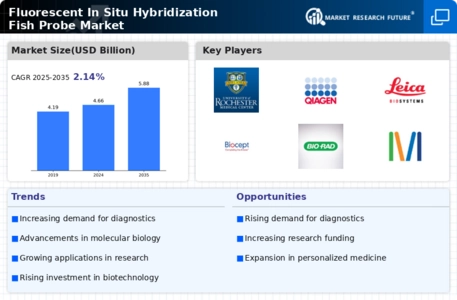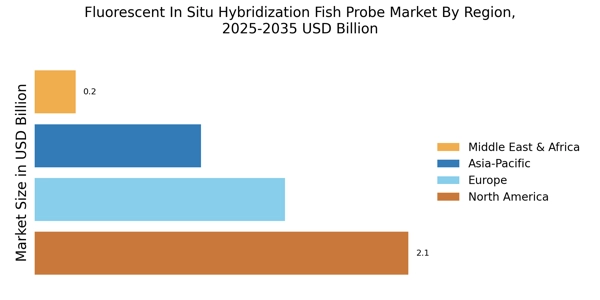Growing Awareness of Genetic Testing
The Fluorescent In Situ Hybridization Fish Probe Market is also driven by the growing awareness of genetic testing among healthcare providers and patients. As individuals become more informed about the benefits of genetic testing, the demand for accurate diagnostic tools like FISH probes is likely to increase. Educational campaigns and initiatives by health organizations are contributing to this awareness, emphasizing the importance of early detection of genetic disorders. The market for genetic testing is anticipated to grow significantly, with FISH technology being a cornerstone in this evolution. This heightened awareness not only fosters a more informed patient population but also encourages healthcare professionals to adopt advanced diagnostic techniques, thereby propelling the market forward.
Rising Incidence of Genetic Disorders
The Fluorescent In Situ Hybridization Fish Probe Market is significantly influenced by the rising incidence of genetic disorders worldwide. As the prevalence of conditions such as Down syndrome and various cancers increases, the demand for accurate diagnostic tools becomes paramount. FISH probes are essential for identifying chromosomal abnormalities, which are critical in the early detection and treatment of these disorders. According to recent estimates, the market for genetic testing is expected to reach USD 20 billion by 2026, with FISH probes playing a vital role in this growth. The ability of FISH technology to provide rapid and reliable results positions it as a preferred choice among healthcare professionals, thereby driving market expansion.
Increased Funding for Genetic Research
The Fluorescent In Situ Hybridization Fish Probe Market benefits from increased funding directed towards genetic research initiatives. Governments and private organizations are investing heavily in genomics and molecular biology, recognizing the potential of FISH technology in advancing medical science. This influx of funding is likely to enhance research capabilities, leading to the development of novel FISH probes and methodologies. For instance, funding for cancer genomics has seen a significant rise, with billions allocated to research projects aimed at understanding genetic mutations. Such financial support not only accelerates innovation but also expands the market for FISH probes, as researchers seek reliable tools for their studies.
Growing Applications in Cancer Research
The Fluorescent In Situ Hybridization Fish Probe Market is witnessing a notable increase in applications within cancer research. FISH probes are instrumental in identifying specific genetic alterations associated with various types of cancers, facilitating targeted therapies. The market is projected to expand as researchers and clinicians increasingly adopt FISH technology for its ability to provide real-time insights into tumor genetics. The global cancer burden is expected to rise, with an estimated 29 million new cases by 2040, further propelling the demand for effective diagnostic tools. This trend underscores the importance of FISH probes in personalized medicine, where understanding the genetic makeup of tumors can lead to more effective treatment strategies.
Technological Advancements in FISH Probes
The Fluorescent In Situ Hybridization Fish Probe Market is experiencing a surge in technological advancements that enhance the efficacy and precision of genetic analysis. Innovations such as improved probe design and enhanced imaging techniques are driving the market forward. For instance, the introduction of next-generation sequencing technologies has enabled more accurate detection of genetic abnormalities, which is crucial in clinical diagnostics. The market for FISH probes is projected to grow at a compound annual growth rate of approximately 7.5% over the next few years, reflecting the increasing reliance on advanced technologies in genetic research. These advancements not only improve the sensitivity and specificity of FISH assays but also expand their applications in various fields, including oncology and prenatal diagnostics.


















Leave a Comment